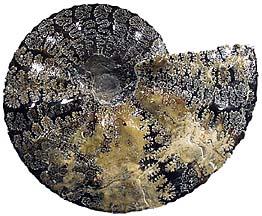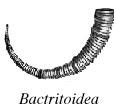Brian Santo*

Placenticeras intercalare
(Cretaceous)
- Phylum Mollusca
- Class Cephalopoda
- Sub-Class Ammonoidea
Ammonites are a distinctive class of extinct invertebrates within the Phylum Mollusca. These spectacular looking marine animals thrived in the Paleozoic and Mesozoic Eras, which equates to approximately 408 to 65 million years ago. The Ammonoidea are ancient cephalopods that are closely related to the modern day chambered Nautilus, cuttlefish (e.g. the Cretaceous Actinosepia canadaensis), octopus, and squid. Their unique, chambered shell shapes have fascinated collectors as well as scientists who use ammonites as index fossils to date the relative age of rocks in which the fossils appear. The proliferation of ammonite species from the Devonian to the Cretaceous has contributed to an abundance of samples around the world and has become useful for indicating the locations of ancient seas within the geologic record.
Heteromorphs

Among the varied species of ammonoids, most of the chambered shell shapes display planispiral coiling such as the Dactylioceras sp. (Jurassic) a trait thought to have evolved from their cephalopod ancestors the Bactritoidea. The bactritids, as they are commonly called, had elongated shell shapes very similar to belemnites (e.g the Cretaceous Belemnitella americana or the Jurassic Belemnopsis hastatus) and baculites (e.g. the Cretaceous Baculite compressus). Other types of ammonoids include the exotic shaped heteromorphs that first begin to appear in the Upper Triassic.

These heteromorphs of the family Choristoceratidae display an unusual partially-coiled shape, which probably limited them to a benthic (bottom-dwelling) lifestyle unlike their buoyant, fully coiled relatives.
Some ammonites are thought to have been able to reach depths of 400 meters, depending on the shape of their shell and internal structure. Overall, they are thought to have been bottom feeders ranging in depths between 50-250 meters. It is speculated that different species of ammmonites may have had a variety of different feeding habits, based on their morphology. The jaw structure of some ammonites seems to indicate that they were active predators feeding on slow-moving animals, while others may have been scavengers. Still others were thought to have scooped up organic debris and trilobites from the sea floor, or fed upon plankton. These creatures were motile but not very fast swimmers. The unique structure of their shells enabled them to pump air, via the siphuncle, into various chambers, giving them neutral buoyancy for vertical movement. The muscular ejection of water through the funnel gave them horizontal propulsion.

Ammonite Geologic Abundance: Devonian - Cretaceous
Ammonite Suture Patterns ® Ammonoid/Nautaloid Comparative Morphology
* The ammonite text and web pages were written and designed by Brian Santo for the Humboldt NHM as part of the course requiremtns for Humboldt's Geology 320, Invertebrate Paleontology, Sp. 1999. They were edited by Melissa Zielinski, and expanded and linked to the Humboldt NHM web site by R. Paselk.
The ammonite engravings on these pages are from Dana, James D. (1870) Manual of Geology, Le Conte, Joseph (1898) A Compend of Geology, or Louis Pirson and Charles Schuchert, A Text-Book of Geology. (1920).
